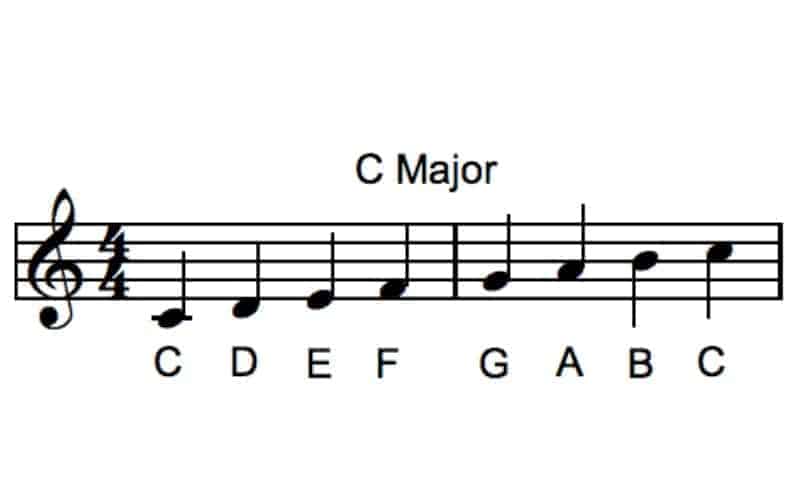Understanding Musical Scales
Understanding musical scales is like learning the alphabet; they’re the building blocks of melodies and harmonies. For budding musicians and guitar players, mastering scales is essential.
It opens the door to countless musical possibilities, from writing beautiful tunes to improvising like a pro.
At Green Hills Guitar Studio, we recognize the significance of scales in your musical journey. Our commitment is to guide you through this essential aspect of music theory, making it accessible and enjoyable.
Get ready to unravel the magic of scales, empowering your musical endeavors with knowledge and creativity. Let’s dive in!
What is a Musical Scale?
A musical scale is like a musical ruler, helping us measure and organize sounds. Imagine it as a ladder of notes, with each step representing a specific sound. These scales are the foundations of every melody and harmony you hear.
Intervals, the spaces between these notes, are crucial. They’re like the gaps between the rungs of the ladder, determining the unique sound of each scale.
Two essential scales you’ll encounter are major and minor scales. The major scale sounds bright and happy, often heard in cheerful songs. In contrast, the minor scale has a more somber, melancholic tone, frequently used in emotional or dramatic pieces.
Both these scales consist of specific patterns of whole and half steps, creating their distinct sounds. In Western music, these scales are the backbone of most compositions.
For beginners, understanding major and minor scales is like learning the primary colors in painting. They provide the basic palette from which you can create endless musical hues.
As you progress in your musical journey, you’ll explore various scales beyond major and minor, adding depth and richness to your compositions.
So, grasp these fundamental scales well – they’re your first steps into the vast, beautiful world of music.
Types of Musical Scales
Firstly, major and minor scales are the cornerstone of Western music. Majors have a bright, cheerful vibe, while minors express deeper emotions with their melancholic tones. Within these, there are natural, harmonic, and melodic variations.
Natural minor scales maintain the standard pattern, harmonic minor scales feature a raised seventh note for a slightly exotic feel, and melodic minor scales differ in ascending and descending, creating a unique musical flavor.
Beyond major and minor, there are exciting scales like the pentatonic, blues, and chromatic scales. Pentatonic scales, with five essential notes, are the backbone of many musical traditions globally.
Blues scales, famous for their soulful sound, add a touch of jazziness to music. Chromatic scales consist of all twelve notes in an octave, offering a rich, colorful sound palette for compositions.
Venturing into non-Western music, we encounter pentatonic scales in Eastern traditions. These scales, prevalent in Asian music, evoke a sense of mystique and are a vital part of many cultural melodies.
Understanding these scales is akin to learning different painting techniques; each one adds unique shades to your musical canvas.
As you delve deeper, you’ll discover the endless possibilities they offer, enabling you to paint musical masterpieces and explore various genres with confidence and creativity.
How Scales are Constructed
Understanding how scales are constructed is like deciphering the musical code that underpins melodies and chords. Firstly, let’s talk about step patterns. Think of these as the specific sequence of whole steps and half steps that create a scale’s unique sound.
For major scales, the pattern is whole, whole, half, whole, whole, whole, half. Minor scales follow a slightly different pattern: whole, half, whole, whole, half, whole, whole. These steps give each scale its distinctive mood, be it cheerful or introspective.
Key signatures play a crucial role in indicating which notes belong to a particular scale. They serve as musical signposts, telling musicians which sharp or flat notes to play within a scale.
For instance, the key of G major has one sharp note, F#. This means every F in the G major scale is played as F#. Key signatures simplify music notation and help musicians understand the tonality of a piece.
Now, for guitar players, understanding these concepts practically on the fretboard is vital. Learning scale patterns and positions on the guitar neck empower you to play melodies and improvise freely.
Imagine these patterns as your musical roadmap, guiding your fingers to create beautiful sounds. Mastering these fundamentals not only enhances your playing but also lays the groundwork for your musical journey ahead.
Importance of Scales in Music
Scales are the heartbeats of music, forming the very essence of melodies and harmonies. Think of them as the alphabet of music; they provide the building blocks for creating beautiful tunes.
Melodies, the soulful tunes you hum, are crafted from scales. Harmonies, the chords that give depth to music, also stem from these scales.
Moreover, scales are the secret sauce of improvisation. When musicians improvise, they create music spontaneously, often on the spot. Understanding scales is like having a palette of colors to paint a musical masterpiece.
Experienced musicians use scales as guidelines, blending different notes to invent unique melodies, solos, or riffs. It’s akin to storytelling, where the scales act as words, and the musician weaves them into a musical narrative.
In the real world of music, countless famous songs and solos rely on specific scales. From the iconic riffs of rock guitar legends to the soulful jazz melodies, scales are everywhere.
For example, the blues scale is the backbone of many rock and blues solos, creating that gritty, emotional sound.
By recognizing these scales in popular music, beginners can grasp their practical applications, motivating them to dive deeper into the world of scales, melody, and improvisation.
Tips for Mastering Musical Scales
Mastering musical scales is like building a strong foundation for your musical journey, and here are some valuable tips to help you along the way. To improve your finger dexterity, practice scales regularly with exercises designed to challenge your fingers.
Start slow and increase your speed as you get comfortable. Focus on proper finger placement to build muscle memory.
Understanding scale patterns and positions on the guitar neck is crucial. Learn to visualize these patterns, making it easier to move across the fretboard. This mental map will enhance your improvisation skills and make learning new songs a breeze.
Consistency is key. Integrate scales into your daily practice routine. Dedicate a few minutes each day to scale exercises. Over time, this consistent effort will lead to significant improvement in your overall playing skills.
Remember, practice doesn’t make perfect; it makes permanent. So, practice smart, stay patient, and watch your musical abilities soar!
Common Challenges (and How to Overcome Them)
Mastering scales can be challenging, but every musician faces similar hurdles. One common obstacle is finger coordination; it takes time for your fingers to move smoothly across the fretboard.
To overcome this, start with simple exercises and gradually increase complexity as your fingers gain strength and agility. Another challenge is memorizing scale patterns. Break them into smaller segments, practice each part separately, and then connect them gradually.
Patience and persistence are your best allies. Don’t rush; progress takes time. Stay dedicated to your practice routine, even when it feels frustrating. Consistent, focused practice is the key to overcoming these challenges.
Also, consider finding a music teacher who can offer guidance tailored to your needs.
Don’t be discouraged by mistakes; they are natural steps toward improvement. Keep practicing, stay positive, and celebrate your progress, no matter how small. With determination and regular practice, you’ll conquer these challenges and become a confident, skilled musician.
Example of the C Major Scale
A major scale is constructed by starting on a tone, going up a whole step, then another whole step, a half step, a whole step, a whole step, a whole step, and then a half step back to the root note one octave higher.
The C major scale: C D E F G A B C
Major scale step formula: root, whole, whole, half, whole, whole, whole, half
Major scales and modes, minor scales and modes, major and minor pentatonic scales, which is the blues scale.

The Coda
In conclusion, mastering musical scales is a fundamental step for musicians. At Green Hills Guitar Studio, we’re dedicated to guiding you through this essential journey.
Our expert instructors are here to help you enhance your musical abilities. Take the next step in your musical adventure – sign up for private lessons today for personalized guidance and expert instruction in mastering musical scales.
Your musical journey starts here!






